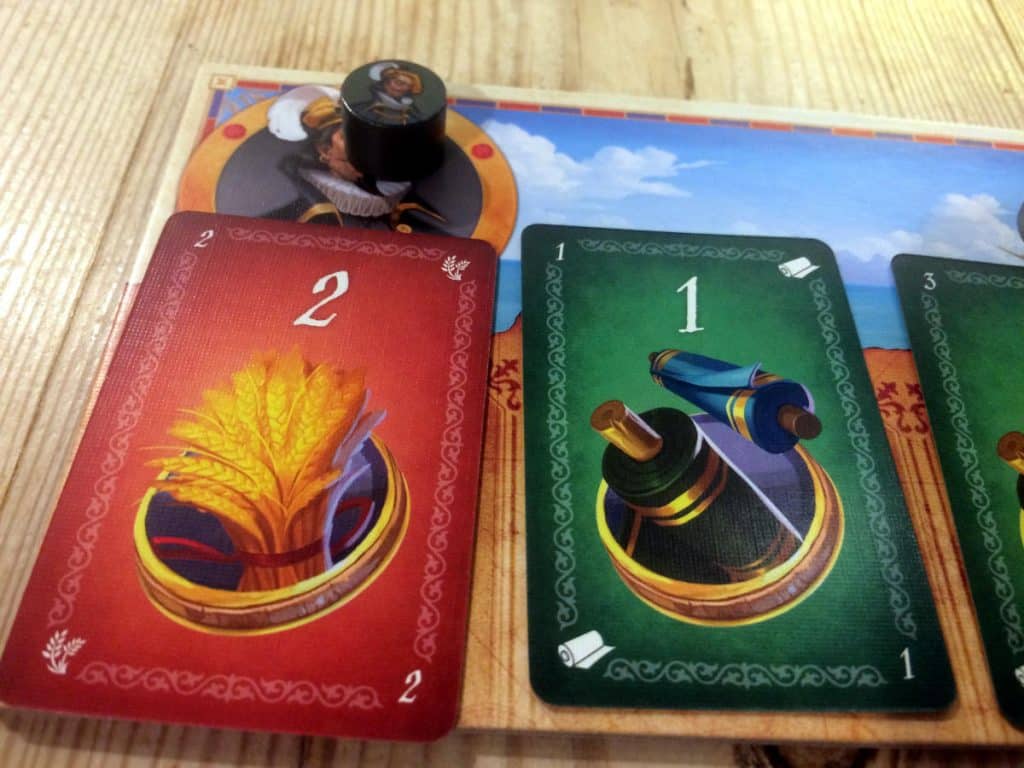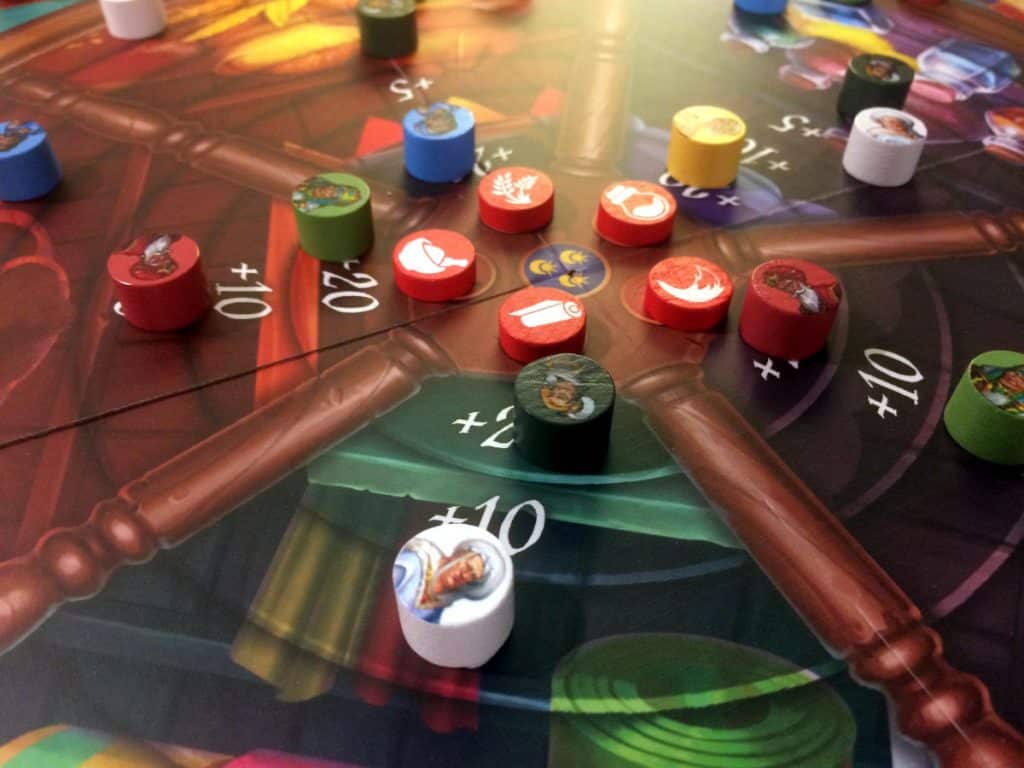| Release Date: 1995 | Players: 2-6 |
| Designer: Reiner Knizia | Length: 30-60 minutes |
| Artist: Rocketbrush | Age: 10+ |
| Publisher: Steamforged Games | Complexity: 1.5 / 5 |
| Plastic (by weight): unknown | Air (by volume): unknown |
Trading in the Mediterranean was profitable, but came with risks. Merchant ships were travelling far to seek out rare spices, precious cloths and many other valuable and lucrative goods. Once a heavily laden ship returned, the goods would be brought to market and auctioned off to the highest bidder. It was never easy to compete with the other buyers and ensure you got the best deal. It was even harder to compete with the infamous and hugely influential trading family, the Medici by Reiner Knizia from Steamforged Games.
Keeping It Simple
I am going to be lazy and quote the rulebook to explain what this game is about: “Medici is an auction game that takes place over three days (rounds). Players take […] turns in presenting goods to be auctioned. Successful bidders will then load these goods onto their ships. Once all ships are full […], the day ends. Players then receive florins (money) for the value of the loads in their ships, and for how much of each commodity they have bought thus far. But be careful – […] money […] is also your end game points!”
It’s that simple. Draw cards to put up for auction, everyone makes their single bid and the highest bidder pays up and gets the goods. Keep going until everyone’s ship is full or the deck is empty. Add up the value of your goods and get paid based on where you are in the ranking. Then count how many cards you have of each type and go up on the five goods tracks to get even more money if you’re highest on any of those. Do this three times and whoever has the most money wins. Oh, and money is points which are money which is points.
All right, I appreciate that might sound a bit confusing, but as you play it all makes sense very quickly. You basically play three rounds, which are divided into two phases: bidding on goods to fill your ships, then scoring those goods once all ships are full. The best thing is to read the rules for the first phase and play through that, then read the rules for the second phase and finish the round. Everything will make sense immediately, but it won’t be until you’ve played a couple of games before you know how much to bid.

Money Is Points
Medici is all about bidding. That’s where the fun comes from. In theory, you could do the maths and work out how valuable auction lots are. So poker players will have an advantage here. The deck of cards consists of five suits, representing the five available goods. Each suit has cards numbered 0 to 5, with the 5 appearing twice and all other cards once.
The total value of cards in your ship, that’s the sum of the numbers on the cards, decides how much money, that’s points, everyone gets. Depending on player count, the highest total gains 30 Florins, as the currency is called in Medici. Second place gets 20 Florins and so on. So you can do the maths.
Of course, it’s not quite that simple. You might think you’ve got the most valuable cargo, but if you have filled up your ship too soon, another player might be able to get even more valuable cargo and beat you to the top prize. Suddenly, your bid was too high and you get back less.
Also, collecting multiple cards of the same suit means you go up that track more quickly. For each of the five goods, there is a corresponding track. At the end of each day, read round, whoever is the highest on each track stands to gain another 10 Florins, while second place gets 5 Florins. Also, at some point up these tracks, you get additional Florins as a reward. So going up these tracks can be very lucrative.
So sometimes having low-value cards, as long as they are of the same suit, can be more beneficial than getting the reward for the most valuable cargo. Of course, if you can achieve both, then you’re laughing all the way to the bank.
Table Talk and Tactics
Once you played Medici a couple of times and have worked out roughly how much lots should be worth, the table talk will start. As the current player reveals the cards put up for auction, you might pretend that you’re really interested, hoping that another player bids high for the lot, when you never had any intention of paying at all. Sometimes you make a bid, just to force another player to pay through the nose. At other times, you are forced to pass and let another player get a valuable lot for a single Florin.
I think that’s where the fun in Medici really begins. You need to be with the right group of people. You want everyone to start bluffing, pretending that they really want a lot, when they have no interest at all. People need to artificially bid up lots, forcing someone else to pay over the odds, who then decides to pass and leave another player with an expensive lot they didn’t really want or need.
There is another layer to the game. Every ship has room for five cards. So once you have bought three, you only have room for two more. If the active player decides to put three cards up for auction, you’re locked out of the lot, because you don’t have enough space. So it is possible to play tactically and let someone else get a lot in the hope that there is less competition for the next lot.
It’s fascinating how such a simple ruleset creates so much fun and excitement. There are so many interesting subtleties that allow for different strategies and ways to deal with the shuffled deck of cards. Medici certainly has a wide appeal. While there is a good amount of randomness, you still feel in control.

Presentation
I never played the original game, but according to Steamforged, this latest production has the same gameplay as the classic version, but it has fully updated the visuals, with all-new artwork and graphics. I must say, the game does look gorgeous on the table. The wooden tokens, including six unique custom ship tokens, are lovely and chunky. The main game board is vibrant and colourful, which is wonderful to look at.
Unfortunately, the colour scheme doesn’t properly match the colours of the cards. I’ve now played Medici with a number of different people and most confuse the grain and spices tracks. It would have been better to tone down the artwork and keep the main colour the same as the backing on each card.
Mind you, every suit isn’t only represented by a colour, but also by a symbol, which also appears on the central game board. So if you’re colourblind, you should be all right. However, it’s not that obvious and as I say, keeping the colours simpler would make things more intuitive.
That’s my only negative remark though.
Overall, Medici is a great game that has stood the test of time. The rules are simple and the game easily plays in 30 to 45 minutes, even with four or more players. It’s a lot of fun seeing how people bid and trying to work out how to respond. Every game is slightly different. You would think it would become boring after one or two games, but I feel you can easily play it four or five times back to back and enjoy it equally from start to finish.
Of course, the setting of the Medici and Mediterranean trading is a bit artificial, but weirdly, it does help make the game a little easier to grasp.
Influential Medici
So, yes, I can highly recommend Medici. It’s become a favourite in our household, because it’s so easy to teach, quick to set up, fun throughout and plays pretty quickly. It’s also interesting how the game changes as player count changes. The game is just as much fun with two people as it is with six, even though you have to adjust your strategy. That’s no easy feat, but Medici delivers with aplomb. Now that it has been re-released by Steamforged, I’d say give it a go and see if you can become the most profitable trader in Italy.
Useful Links
- Medici: https://steamforged.
com/ en-gb/ products/ medici-board-game - Rulebook: https://steamforged.
com/ cdn/ shop/ files/ Medici-Rulebook-Digital. pdf? v= 6530382457095034148 - Steamforged Games: https://steamforged.
com/ en-gb - BGG listing: https://boardgamegeek.
com/ boardgame/ 46/ medici
Videos
Transparency Facts
I feel that this review reflects my own, independent and honest opinion, but the facts below allow you to decide whether you think that I was influenced in any way.- I was sent a free review copy of this game by the publisher.
- At the time of writing, neither the designers, nor the publisher, nor anyone linked to the game supported me financially or by payment in kind.
Audio Version
Intro Music: Bomber (Sting) by Riot (https://www.
Sound Effects: bbc.co.uk – © copyright 2024 BBC
Village Ambiance by Alexander Nakarada (CreatorChords) | https://creatorchords.
Music promoted by https://www.
Creative Commons / Attribution 4.0 International (CC BY 4.0)
https://creativecommons.
Playlist
These are the songs I listened to while I was writing this review:

